In the first post of this series, I outlined 5 things that went right with The Force Awakens, the seventh movie in the Star Wars series. Overall, I am a fan of the film, and although I don’t like it quite as much as the original trilogy, it is a worthy addition to the series and a good deal closer to the original trilogy than to the disappointing prequels.
When I first saw the film, I wondered if I might even rank it in the top 3 Star Wars movies. In the end, I think it is not quite up to that level, and here I present 5 reasons why.
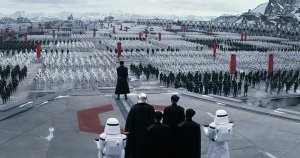 1. A Sequel… And A Non Sequitur
1. A Sequel… And A Non Sequitur
Sequel and non sequitur have the same Latin root. A sequel is something that follows, and a non sequitur is something that does not follow.
In my previous post on the 5 things that went right with The Force Awakens, I highlighted the Han Solo/General Leia/Kylo Ren storyline as following smoothly from the original trilogy – a rich story that unfolds naturally from the personality traits of Han and Leia that were established in the original movies. As strongly as that storyline followed from the original trilogy, the rest of the back drop – does not.
Thirty years before The Force Awakens, the rebellion has utterly defeated the Empire. Darth Vader is dead and redeemed and he has destroyed Emperor Palpatine. As far as we know, these are the only Sith Lords in the galaxy – and they’re dead. Furthermore, the Empire’s ultimate weapon – the second Death Star – was destroyed, and the Imperial Fleet routed in an unsuccessful defense.
There seem to be two likely outcomes here over the next 30 years. Possibly the leaders of the rebellion – likely led by Leia – locate the remnants of the Senate of the Old Republic and stitch together a new coalition, probably guided by a reemergence of the Jedi Order under Luke’s guidance. Or more likely – because this is our own history of most successful rebellions (think Mao in China or Robespierre in France or Lenin in Russia) – the galaxy plunges into a chaos of warring factions, petty dictators, and dysfunctional fledgling federations. In this scenario Leia might be fighting against a new tide of disunity, and Luke might indeed find his pupils swayed by promises of power from the outside.
What seems unlikely – in 30 years! – is the emergence of The First Order. What also seems unlikely is a new, powerful, strong leader should emerge in this mysterious Supreme Leader Snoke (more on him later).
File this under a missed opportunity. What could have been – a galaxy plunged into chaos, with no certainty who is friend and who is enemy – with gangsters like the Hutts vying with the Kylo Rens of the world – unable to control their nascent powers – with remnants of the Old Empire allying with the restless of the Old Rebellion – within this backdrop is an opportunity to tell the kind of stories that Star Wars hasn’t yet had the chance to tell. A backdrop in which right and wrong (light and dark) aren’t so obvious.
Instead, the writers of The Force Awakens played it safe, “resetting” the Star Wars universe right where we first joined it – with a powerful, evil leader (the Emperor/Supreme Leader Snoke), a militaristic martinet (Grand Moff Tarkin/General Hux), a dangerous protege (Darth Vader/Kylo Ren), and a dominant fleet of powerful vessels. These setting out to ruthlessly destroy beneficent politicians (The Imperial Senate/Galactic Senate Of The New Republic) protected by a ragtag underdog fleet (the rebellion/the resistance) and supported by untrained wielders of the Force (Luke Skywalker/Rey). Obviously the similarity of The Force Awakens and Star Wars is one of the chief complaints about the former; my complaint here is not that recent movie is derivative so much as it missed an opportunity to really follow from the galactic situation following Return of the Jedi. An interesting untold story.
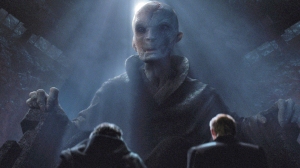 2. Supreme Leader/Supreme Disappointment
2. Supreme Leader/Supreme Disappointment
Kylo Ren is a fascinating bad guy. I like that he serves the Darth Vader role here, without being Darth Vader. He’s dangerous, like Vader, but Vader was dangerous because he was powerful and calculating. Ren is dangerous because he’s powerful and unpredictable. Vader was dangerous because he was completely aware of and confident in his own capability – “When I left you, I was but the learner: now I am the master.” Ren is dangerous because he is not completely aware of his power and he struggles with fear that his power or his resolve will fail him.
With Supreme Leader Snoke, there is no depth at all. True, we had no depth of understanding of Emperor Palpatine until Return of the Jedi, despite glimpses in The Empire Strikes Back. So maybe this is a premature complaint. But there’s more to be bothered about: why does he look like that? Is he human? Just decrepit, like The Picture Of Dorian Gray (and for the same reason)? And where did he come from? We had no knowledge that any other Sith existed, yet this one, by the end of The Force Awakens, promises to finish Ren’s training, and we are led to believe he is as powerful as Palpatine was.
And the worst part of Snoke? He’s CG. Perhaps he might have been better not seen (the giant hologram looked a bit ridiculous). He could have been heard and not seen, and I think these scenes would have been more effective.
Now, there may be a good explanation for his rise to power – perhaps the writers are building up a mystery to a nice, satisfying reveal in future films. If so, it better be damn good! I’d hate to see us have to wait for Episode 6A, 6B, and 6C – another prequel trilogy, wedged in what looks to be a very eventful 30 year period between Jedi and Force Awakens.
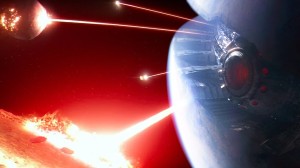
Image not to scale: parsecs are missing.
3. Starkiller Base
I’ll bet if you took a poll, The Empire Strikes Back would be rated as the best of the Star Wars movies (this guy | this guy| this guy | not this guy | this guy). I go back and forth myself – I like all 3 of the original films nearly equally, and believe each has unique strengths – but certainly I can’t disagree with anyone who puts Episode V at the top of the list. What’s interesting about that selection is that, kind of uniquely among Star Wars films – there’s no climactic battle at the end. It certainly stands out in those first 3 films – no Death Star. Empire didn’t need that to be a great movie, and neither did The Force Awakens.
The problems with Starkiller Base are legion. First, it’s a completely implausible weapon. Yes, I realize the Death Stars are virtually implausible too, but maybe, with the Emperor driving them, a massive space station could be built around a cannon harnessing enough energy to batter a planet. Maybe. But Starkiller Base? Sucking the entirety of a sun (in a few hours), not overheating (thanks to the thermal oscillator?), and then delivering the force of its power across hyperspace to bullseye a target across parsecs? (That’s got to be a lot harder than hitting a womp rat from a T-16!) What the what? Is there no recoil?
Since Starkiller fired twice, was there 2 suns to use up? Or did they fly the planet to another star to use the second one up? How does the snow stay on the planet while it’s extracting solar energy? What happens to all the people on the planet as the sun slowly blinks out? If the planet is somehow not getting absurdly hot from this weapon charging, shouldn’t it be getting absurdly cold from the destroying of its sun?
All of this was made necessary – in the minds of the writers – by presuming the audience would not be satisfied without a climactic end battle. In addition, the audience would need that battle to be against a weapon more powerful than the Death Star. (Of course, it turned out to be much easier to lower Starkiller Base’s defenses than it was to lower the defenses of either Death Star – just threaten Captain Phasma with a blaster before throwing her in the garbage chute?) This was the same kind of “it’s got to be bigger and badder” nonsense that Abrams used to ruin Star Trek for me.
In spite of its really bad ending, The Force Awakens still managed to have – a really good ending. Starkiller Base was a throwaway distraction to: 1) the death of Han Solo, 2) Chewbacca’s crossbow strike on Kylo Ren, 3) Finn’s losing lightsaber battle with Ren, 4) Rey’s triumphant besting of Ren for force control of Luke’s lightsaber, and 5) Rey’s ass-kicking of Ren using said lightsaber. Abrams’ instincts were right in exactly half of the film’s final scenes.
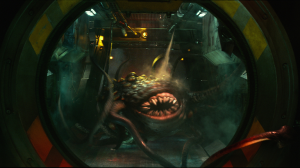 4. And Now For Something Completely Different: Rathtars Loose!
4. And Now For Something Completely Different: Rathtars Loose!
Another of the great sins of the prequels was the action scene that seemed designed with future console video games in mind (rather than, you know, the ongoing plot of the movie). A for-the-hell-of-it action scene. The first example was the pod race. Now, supposedly that was tied to the plot – because Jedi can’t figure any better way off of a planet than to sponsor a 9 year old in a potentially lethal pod race that the kid has never even completed, much less won. And it’s tenuously connected to character development, because in Star Wars Kenobi told Luke that his father was “a fine pilot” (pod racing being what no one in the universe had in mind when Kenobi said this). Attack of the Clones was even worse, giving us both the droid factory scene and the gladiator scene in succession. Particularly the droid factory was implausible, cartoony, and pointless with regard to the plot of the movie or its character development. I can’t remember a single action scene like that in the original trilogy, though of course the temptation of cashing in on a video game was much less then. Still, the original trilogy managed fantastic action scenes (destroying the Death Star, fleeing Hoth, rescuing Han from Jabba’s Palace) that emerged naturally out of the needs of the plot.
For the most part, The Force Awakens gives us integral action scenes. The whole flight of Finn from the First Order – first with Poe and later with Rey – was a great example of how to open a movie with action and that advances character and plot. I’m less enthused about the destruction of Starkiller Base (see above), but certainly the death of Han Solo and the duel of Rey and Kylo Ren simply had to happen to tell this story – exciting and integral action. Ditto Rey’s capture on Takodana followed by the reunion of Han and Leia.
The misstep was in the middle of the movie. Obviously, Han and Chewbacca and Rey and Finn (and BB8 and the Millennium Falcon) must come together at some point. And it couldn’t hurt if they bond through some kind of danger – Han has to learn to trust and respect Rey if the plot is to move forward. But as cool as the rathtars looked, the whole thing struck me as a bit hokey (and video gamey). Two rival gangs that Han Solo owes money to (one from Dublin, apparently, or maybe Belfast) arrive – at the same time (?) and sneak onto his ship (?) and demand their money (?). Then some giant squid monsters escaped because Rey trips the wrong fuse (?) and only the bad guys get swallowed (?) and all the good guys make it out alive. (Including the 70-year old Han and Finn, who is dragged through the ship in the beast’s clutches.) Since Han is dead, you can be sure these rival gangs will now completely disappear from the Star Wars universe, having served virtually no purpose. Maybe the rathtars will show up with their own booth at a renewed Imperial Senate?
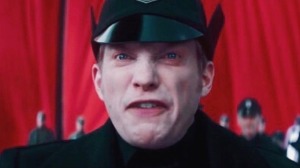
Hey Hux: say it, don’t spray it!
5. That Hux Guy: He Really Likes Order!
While I loved Kylo Ren, you can see from this list (point #1, #2, #3, #5) that I wasn’t really sold by the enemy of The Force Awakens. This could all change with future revelations in the forthcoming films, but it’s just a bit hard to believe so much galactic fury could be built from the ruins of the Empire and the death of the Sith in just three decades.
In the original trilogy, Grand Moff Tarkin was always a mystery. By all rights, Darth Vader should surely have been the leader of the military, but Tarkin was his superior (“Governor Tarkin, I should have expected to find you holding Vader’s leash.”) and the engineer of the Death Star felt perfectly free to needle Vader (“Don’t try to frighten us with your sorcerer’s ways, Lord Vader.”) In The Force Awakens, General Hux seems to have a similar status to Tarkin. Indeed, we never saw Tarkin having a confab with the Emperor, but Hux is seen beside Kylo Ren in conference with Supreme Leader Snoke.

Hux’s older brother?
So who is this guy? How, lacking any mastery of the force (we presume) did he rise to such power? And why is he so darn angry? Is he OCD on a universal scale, so that any disorder makes him angry enough to blow up several planets with each tantrum?
There actually is a place for a character like this. In a post-Empire galaxy (see point #1 above), the ensuing chaos might indeed create a vacuum for a megalomaniac promising order. Again, it’s happened many times in history. But this isn’t quite the backdrop Hux finds himself in, and so his motivations are somewhat obscure. It doesn’t help that the portrayal was not exactly subtle. It will be interesting to see if this character has a role in future films, or if he will be another Darth Maul – a one-shot forgettable villain.